![]()
By Rob Harris | Updated: Saturday, 12 July 2014 12:44 pm
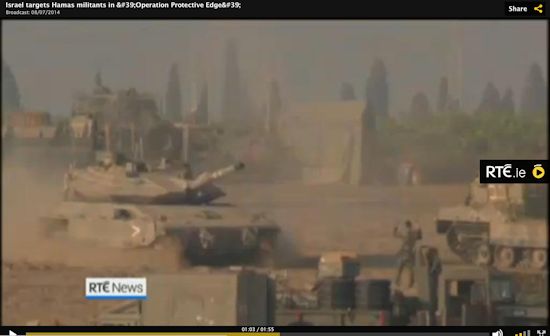
RTE News: “Dozens of tanks and bulldozers have amassed along the border with Gaza…in a true show of force and determination”
Faced with an asymmetrically powerful opponent, Arab-Palestinian terrorist groups have no realistic hope of winning conflicts militarily. However, they can use conflict to strengthen their hand in a number of ways. By bringing violence to Israel’s door, in assaults where they have no hope of overwhelming their foe, their political esteem in the Islamic world is nonetheless raised substantially. The Arab-Palestinian populace, radicalised from youth, also finds favour in such conflicts, despite the hardship it often brings.
With the onset of any protracted conflict between Israel and the various Arab-Palestinian military factions, so much of the substance of a given fracas comes to be waged on television screens across the world. The fight, as per Hamas’ stated strategy, should be taken into civilian Arab-Palestinian areas, to use the people it purports to represent as human shields. Fittingly, its operational headquarters, during the 2009 Cast Lead war, was located in Gaza’s Shifa Hospital.
With every war comes graphic images of Arab-Palestinian suffering, ending in a public relations disaster for Israel. Some of this imagery is faked as has so often been the case in the past, or it can be stripped of context by elements in the media. Some journalists also follow far-fetched pro-Palestinian narratives without critique. Some reports featured subtle justification for the recent widespread Arab rioting. Some lay blame at Israel’s door for any act of self-defence, and interpret motives in a fashion wholly disconnected from obvious facts.
The prejudicial narration of one RTE report
A July 8th news report by Niamh Nolan (or see from 7:48 found here) featured on Irish public service broadcaster RTE’s Lunchtime News (frequently repeated on RTE’s news channel), can be justifiably seen as one of the many recent examples of the mainstream media’s close observance of the pro-Palestinian narrative. The report shares a number of common features with that of the prejudicial coverage in other mainstream and international news sources. Below is a full transcript of Ms. Nolan’s two-minute report.
“The air-strikes hit before dawn. The injured were rushed to hospitals in Gaza City. Palestinians say the rocket attacks injured as many as fifteen, including two women and a child.
At one scene residents used the light from their mobile phones to search the rubble for their belongings.
Sunrise over Gaza, and the full scale of the damage is visible. This house, one of two flattened by the Israeli’s, was evacuated in time. This was Selem Selemi’s home, where he lived with his ten children. He says [English translation] “the army called after three AM and asked us to leave. Ten minutes after evacuating they attacked. The house is totally destroyed.”/”
It’s hard to see past the destruction.
Israel have stepped up their offensive against the Hamas militants in a campaign named Operation Protective Edge. Dozens of tanks and bulldozers have amassed along the border with Gaza, lined up in fields in a true show of force and determination.
[Statement by Israeli official Mark Regev:] “Israel defence forces are currently acting to put an end to this once and for all. Our goal is to free the people of Israel from the threat of these incoming rockets.”
Those rockets were fired into Southern Israel by militants in Gaza, enraged by the reported death of five of its forces in Sunday’s strikes.
Hamas warns it will continue to hit targets in Israel unless the air-strikes stop. But the Israeli position has now moved into one of escalation rather than de-escalation.
Niamh Nolan, RTE News.”
A distorted sequence of events
Niamh Nolan’s report fails to mention Hamas’ rocket attacks, until the brief statement made by Mark Regev, more than half-way through the report. This is a substantive omission that skews the sequence of events, to present Israel as acting in a wholly aggressive fashion, without any provocation.
The reporter worsens this inaccuracy by then claiming that Hamas had fired the aforementioned rockets at Israel after the Jewish State killed five of its terrorists, two days previously. This statement is misleading for two reasons. The group of five or six Hamas members likely died handling explosives in a tunnel designed to attack Israel. This incident was used by Hamas to justify stepping up attacks on Israel.
Secondly, Israel had targeted Gaza due to persistent rocket barrages, which had gathered pace since the kidnap of three Jewish Israeli teens on June 12th, who were subsequently murdered, in all likelihood by Hamas operatives. None of this context is provided, despite the opportunity to do so in what was a relatively slow-moving report, which lingered on the damage Israel’s bombing raids caused in Gaza.
The inaccuracy is further compounded by failing to mention the dramatic upturn in rocket attacks, to an almost unprecedented level. An 80 rocket barrage hit Israel within the space of a few hours, with no mention of the chaos it caused to the populaces of Israeli towns nearest the Gaza border, where it effectively paralysed life.
Notably, other popular news outlets have presented the same lopsided narrative. For example, the BBC and the New York Times have both suggested Hamas is responding to Israeli attacks, rather than the other way around.
Escalation or proportionality?
At the end of the report, after presenting Israel as the true aggressor, Nolan states that Israel is set on a course of “escalation rather than de-escalation”. Whilst Israel is stepping up its Gaza strikes, this view is not in keeping with the fact that Prime Minister Benjamin Netanyahu has been open to compromise.
Netanyahu has acted with relative restraint to the protracted rocket fire, for which he was strongly criticised. Israeli forces conducted a modest number of reprisals, until the dramatic increase of rocket attacks on Sunday last.
Before the increase in military strikes, Netanyahu gave Hamas repeated opportunities to scale back their assault on Israel:
“Amidst increased rocket fire at the Israeli south and threats from Hamas to expand range of rockets, Prime Minister Benjamin Netanyahu said Thursday that if Gaza rocket fire stopped then Israel would also halt its actions.”
Last week, Netanyahu is also rumoured to have given Hamas a 48 hour deadline to stop the attacks, via an Egyptian intermediary. Netanyahu’s reaction, prior to military actions on Sunday, was one of relative restraint, until it became clear Hamas’ rocket barrages would not desist.
By contrast, Hamas rejected a de-escalation. Hamas spokesman Fawzi Barhoum stated:
“This is not the time for quiet. We have a bank of various targets. An Iron Dome [Israeli missile defence system] will be needed in every Israeli home.”
The importance of images
The report featured lingering images of the destruction of Gaza. The image-led narrative may possibly suggest that Nolan’s narration followed a video sequence constructed by RTE’s news production team.
Tellingly, the report’s imagery presents a rather overt dichotomy: for the Arab-Palestinian side, it is one of innocent suffering; for Israeli’s, it is intense militaristic aggression. The report focused on the destruction of Selem Selemi’s Gazan house — an appropriate human interest story, but there was no question of the reasons for Israel’s targeted attack, in which they chose to forewarn the residents.
There have been a number of reported instances of Israel specifically targeting the homes of Hamas operatives. Often, residents claim to be civilian but some of these stories can be discounted, along with the suggestion the homes did not store weapons or munitions. The Washington Post recounts one such incident in the present conflict:
“Ahmed Kawarea said he ran home when he heard about the first rocket. The second missile hit when he was in the stairwell on his way to the roof.
“We are civilians,” he said. “We don’t have anyone who lives in the house who works in the resistance.”
But neighbors suggested that one of the occupants was a member of the military wing of Hamas. Soon after the house was hit, a man pulled a sidearm out of his waistband and scurried into the gutted building, saying he had been sent to retrieve a laptop computer from the debris.”
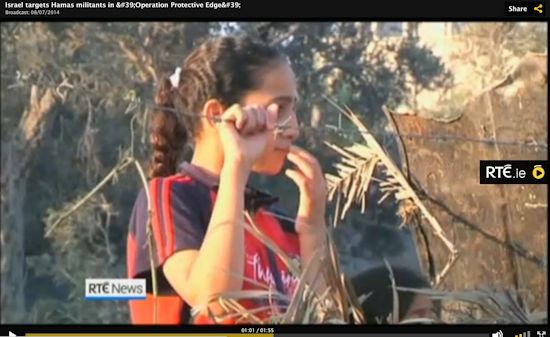
RTE News presents the viewer with emotive images of a young girl looking past barbed wire, with the narrative line “it’s hard to see past the destruction”
The RTE report presents the viewer with emotive images of a young girl looking past barbed wire, with the narrative line “it’s hard to see past the destruction”. Realistically, news reports that display some level of artistic licence, which draw the viewer into the story, are not necessarily a bad thing. However, with contentious news stories, an appropriate level of care is required.
In this instance, there was no corresponding footage of attacks in Israel, except a few seconds of ambiguous footage of a field on fire, shown after video of a regimented line of IDF bulldozers.
Despite many applicable examples, there was no corresponding human interest angle presented of the Israeli side.
The report’s references to non-specific Israeli “targets” that Hamas wish to hit, further emphasises its divergent treatment of both populaces, since these targets are solely civilian — Israeli towns and cities. The report’s oddly depersonalised treatment of this issue is noteworthy because the terrorist group has recently stepped up its rhetoric, with boasts of targeting civilians, in a further effort to intimidate.
Broader ethical issues in RTE coverage
Other RTE reports have been more balanced in their coverage but a variety of their reports nonetheless downplay the impact of rocket fire despite Hamas’ long range rockets reaching as far as Jerusalem and Tel Aviv, Israel’s Iron Dome defence system somewhat limited in its capacity to intercept the large number of projectiles.
Hamas use both involuntary and voluntary human shields, as evident in footage from recent air strikes, and reports from Gaza itself. The resultant effect of voluntarily taking part in a conflict, by assisting one side’s objectives, represents the most fundamental feature of belligerency as distinct from that of civilian categories. However, such individuals tend to be classified as civilian by media institutions generally, with RTE failing to ever mention that there have been numerous reports of the application of such strategies, on the part of Hamas’, whilst omitting from coverage the fact that Israel forewarns civilian areas of impending strikes.
Problems of methodology arise with the reportage of casualties. RTE’s news programmes frequently repeat headlines throughout an allotted time-slot. With the present conflict, these segments habitually refer to death tolls. Such references are appropriate but they do not distinguish between the death of militants and those of other groupings. This form of reportage is politically leading for several reasons. Palestinian narratives markedly conflate such categories in missives concerning death tolls, and have used misleading imagery of civilian suffering in a persistent fashion. The present conflict is proving to be no exception in this regard. It constitutes conflict propaganda.
Similarly, RTE tends to lead in its reports with figures of overall Arab-Palestinian casualties. Its recent reports assert that no casualties on the Israeli side have been reported. For example, Joan O’Sullivan’s Lunchtime News report (July 9th) stated:
“No injuries have so far been reported as a result of the rocket attacks.”
O’Sullivan, in an otherwise quite balanced report, may be making this assertion with respect to the given day of the report but it is unclear, as on other occasions (Carole Coleman, 6.1 News report, July 10th). Such assertions, without clear contextualisation, will inadvertently reinforce notions that Israel’s response is disproportionate, even though their stated aim is to simply silence rocket attacks on their towns and cities. There have been a modest number of reports of injury, both physical and Mental, as a consequence of the rocket barrages. For example, on the 7th it was reported that a woman and child from the town of Askelon were being treated for shrapnel injuries, with others suffering mental distress.
RTE’s July 10th News with Signing (AKA ‘News for the Deaf’) text-based bulletin (see at 9:30) stated:
“The UN Secretary General has warned that the situation in the Middle East is on a knife edge. He said that the region cannot afford another full blown war and has urged Israeli and Palestinian militants to end hostilities.”
As with many other news outlets, it is problematic for RTE to consistently describe Hamas as “militants”, when the EU, of which Ireland is a full member state, recognises the group as a terrorist entity. However, the phrase “Israeli and Palestinian militants”, wording that UN Secretary General Ban Ki-moon does not appear to have used personally in the statement so described in the News with Signing report, negates not only the Israeli Defense Forces’ sovereign status, it also represents a rather extraordinary degree of moral relativism, in view of Hamas’ “dead baby strategy”, which was publicly reaffirmed by Hamas Spokesman Sami Abu Zuhri this week.
“Obsession, Exclusion and Double Standards – the Points of Prejudice in the Coverage of an Emergent Third Intifada” portrays another example of RTE’s coverage of the conflict.
Rob Harris contributes articles to several websites on contentious political issues (not to be confused with the popular English novelist (1957-) of the same name). He blogs at eirael.blogspot.com. He lives in Ireland. For all the exclusive blog entries by Rob Harris, go here.



 RSS
RSS

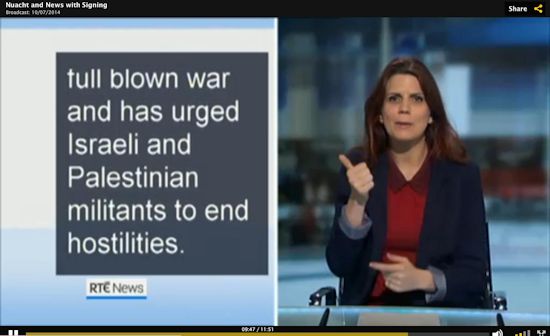


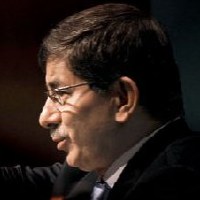

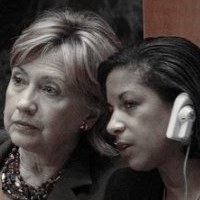










Latest Comments
Hello Mike, Thank you for your positive feedback to the article. I felt there wasn’t too much critical analysis of ...
Thanks for this considered and well constructed article. A follow up article on the manner in which the editorial contro...
THE CLUELESSNESS OF CLAIMING THAT OBAMA'S MIDDLE EAST POLICIES WERE A FAILURE CANNOT BE FURTHER FROM THE TRUTH, WHAT THE...
As long as Obama is the president of the usa do not trust the us government......
Thank you for an good read....